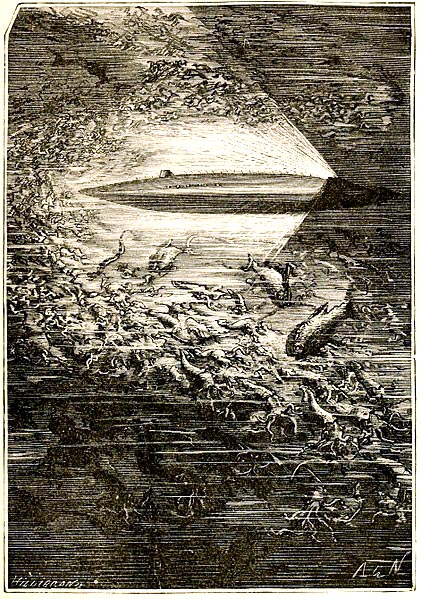 |
| The Nautilus (Wikipedia) |
Note: The mysterious Captain Nemo (meaning "no one") cruises the world under the sea--long before that technically became possible!
Get Ready: Are you interested in marine biology--undersea life and so on?
20,000 Leagues Under the Seas by Jules Verne is often considered to be one of the most prescient of the early works of science fiction. For example, the 1870 novel accurately describes many features of modern submarines.
Like another of Verne's books, Around the World in Eighty Days, the story involves a long journey--one of 20,000 leagues or about 80,000 kilometers, in fact. And like Moby Dick, the journey is led by an enigmatic captain, this one named "Nemo" (meaning, as we learn from The Odyssey, "no one").
The nations of the world share a problem: a mysterious sea monster has been sighted in various places. The U.S. government sends out an expedition, which includes a French marine biologist (and the book's narrator), Professor Pierre Aronnax; his valet Conseil (like Phileas Fogg's Passepartout), and a Canadian harpooner named Ned Land.
After five months, the expedition nears Japan, where the monster damages the ship's rudder. Our heroes are thrown overboard, and end up atop the monster--which is not a creature at all, but a futuristic submarine! They wait on deck until morning, when they are brought inside and introduced to the designer and commander of the craft, the mysterious Captain Nemo.
Many adventures ensue. Along the way, the passengers discover that, in order to maintain the secrecy of his mission, Nemo does not intend to release them: they must travel with him until they die. The Professor and his man are enthralled by the chance to explore under the sea, but Ned longs to be free again.
They visit coral reefs, sunken battleships, and even the lost world of Atlantis. Most famously, they survive an attack by a giant squid. The passengers learn more about Nemo, too: he built his submarine, the "Nautilus," partly as a means of exploring the undersea realm, and partly to escape the power of "terrestrial" governments--especially one in particular.
It seems his homeland had been invaded by an imperialist nation, and in the process his family was slaughtered. Eventually, a warship of that nation attacks the Nautilus, and Nemo rams it, sending it to the bottom of the sea with its entire crew.
After that, Nemo is deeply depressed, and the ship's previous rigorous discipline and purposeful navigation fall by the wayside. At last, seeing a chance to escape, the three board the submarine's skiff and row toward land. At the same time, the Nautilus is caught in a maelstrom and drawn deeper and deeper. The survivors reach a desert island off the coast of Norway, but the submarine's fate is unknown.
--------Read more: https://en.wikipedia.org/wiki/Twenty_Thousand_Leagues_Under_the_Seas
Practice: Match the term to its definition below:
- craft
- enigmatic
- enthralled
- imperialist
- maelstrom
- marine biologist
- prescient
- purposeful
- rudder
- skiff
- gaining power over other countries
- a vessel
- one who studies sea life
- fascinated
- with clear intention
- having knowledge of things before they happen
- a steering mechanism
- a small boat
- a whirlpool
- mysterious
Answers are in the first comment below.
Submitted to the Shenzhen Daily for May 11, 2021


Answers to the Practice: 1. b; 2. j; 3. d; 4. a; 5. i; 6. c; 7. f; 8. e; 9. g; 10. h
ReplyDelete